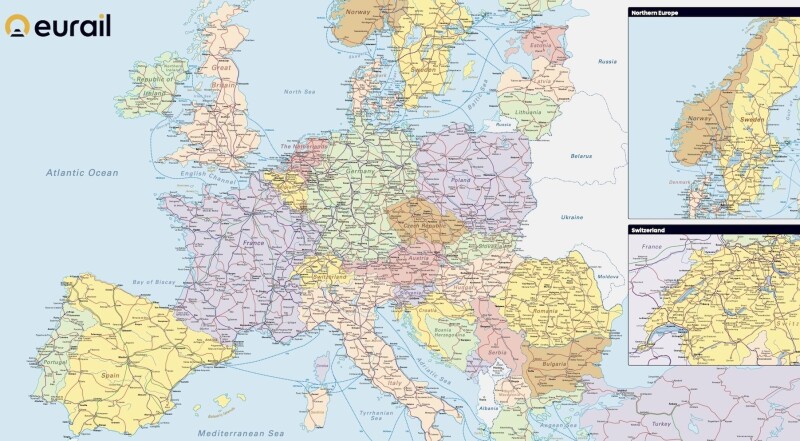If you’re planning a multi-city tour of the European continent this year and will rely on trains to get around, you may want to consider purchasing a Eurail Pass. Consider it your golden ticket to a seemingly limitless number of train rides across Europe. Eurail Pass is a single document that allows non-European residents/citizens to travel by train all over 33 European countries, across roughly 155,343 miles. Your trips must occur over a specified period of time, and the pass eliminates the need to buy individual point-to-point tickets.
The Eurail Pass, which was founded in 1959, can be used for riding local trains, high-speed trains, and even night trains. In addition to the flexibility and time-saving benefits it affords, traveling with one can also save you money, depending on your travel plans.
Here’s everything you need to know about Eurail Passes before you plan your trip to Europe.
Eurail vs. Interrail
Eurail is not cheaper than Interrail. Their prices are exactly the same, but Eurail is for non-EU residents and citizens.
How do Eurail Passes work?
You can choose from either a One Country Pass, which covers train travel in a single country, or a Eurail Global Pass, which offers unlimited train travel across 33 countries in Europe, using their national railroads. Within each pass type, there are even more options—for children (ages 4 to 11), youths (12 to 27), adults (28+), and seniors (60+). These come in first- and second-class options across all age categories.
Eurail passes are great for families and are extremely cost-effective. Kids age 3 or younger don’t need a pass at all (to travel on an adult’s lap), and children age 4 to 11 are eligible for a free Child Pass. Up to two children are allowed to travel for free with one adult. Find out more about family discounts here.
The passes also cover different trip lengths for both the One Country and Global Passes. If you’re going on a shorter getaway and won’t be taking trains regularly, you might want a pass that covers four days in a single month. A Global Pass with three months of unlimited travel, say, is best for a long trip where you plan to cover a lot of ground.
Eurail Passes are sold by the number of days you plan to use them. Each travel day covers as many trains as you’d like to take in a 24-hour time window from 12:00 a.m. to 11:59 p.m. on the same calendar day. Keep in mind that there are exceptions to be made if you’re taking a night train. For example, if you book a train that leaves on Monday night and arrives on Tuesday morning, you will only need to use one travel day (the day of your departure) to cover that trip. However, if you choose to board another train on Tuesday, you’ll have to use another travel day on your pass.
One Country Eurail passes cover:
- Three days within one month
- Four days within one month
- Five days within one month
- Six days within one month
- Eight days within one month
There are two types of Eurail Global passes, flexible and continuous. The flexible options are:
- Four travel days within one month
- Five travel days within one month
- Seven travel days within one month
- 10 travel days within two months
- 15 travel days within two months
The continuous Eurail Global passes are:
- 15 days in a row
- 22 days in a row
- One month
- Two months in a row
- Three months in a row
You can figure out which Eurail pass is best for your vacation by telling Eurail’s trip planner where you plan to go.

Take the train around Cinque Terre with your Eurail pass and savor Mediterranean views.
Photo by Julia Lav/Shutterstock
Where can you buy a Eurail Pass?
You can buy any type of Eurail Pass online from Eurail.com, but several other sites sell them, too. RailPass and Rail Europe are both authorized vendors that sell Eurail Passes for roughly the same price as Eurail.com, with slight variations in insurance and service fees.
Some offer free shipping (if you want a paper pass) and others special discounts and promo codes on tickets, so it’s best to check all your options before purchasing your pass to make sure you’re getting the best deal.
You can also purchase Eurail Passes at train stations in Europe, but that’s more expensive than ordering them online in advance.
How much does a Eurail Pass cost?
These are some 2025 starting prices of a Eurail Global Pass for adults purchased directly through Eurail:
- Four days in one month pass: $325 for second-class and $413 for first-class
- Seven days within one month pass: $438 or $557
- 15 days within two months pass: $636 or $807
- Three-month unlimited pass: $1,099 or $1,396
A two-month unlimited pass costs $950 in second class or $1,206 in first, so, if you plan to travel for 10 weeks, do the math to see whether it’s worth springing for the three-month pass.
One Country Passes are slightly more affordable and vary by country, but they truly are for only one country and can’t be used on cross-border trains. A six-day adult pass for Italy, for example, bought directly from Eurail, is $284 second class and $361 in first. The big caveat with One Country passes, though, is that the longest pass is eight days within one month.
Eurail also groups certain regions, so you can get multiple countries for the price of one with its Benelux Pass (Belgium, the Netherlands, and Luxembourg) and Scandinavia Pass (Denmark, Finland, Norway, and Sweden). Note that Eurail does not offer One Country Passes for certain countries that are included in the Global Pass, such as Switzerland, Montenegro, and Bosnia.

The mobile version of the Eurail Pass is user-friendly and makes it easy to stay organized.
Courtesy of Eurail
Are Eurail Passes worth it?
It depends. If you know you’ll have four travel days over a one-month period, a second-class pass would cost most adults $325—or $81.25 per day. If the train you need to take costs more than $81.25 each way, or if you’ll be taking multiple trains in one day that add up to more than that, it’s worth buying that pass. If you only need a less costly regional train to get between cities like Amsterdam and Brussels or Marseille and Nice, however, then it’s probably not worth it.
For those who would argue that buying $50 Ryanair or EasyJet flights to jump from city to city is faster and cheaper, keep in mind that once you add on arriving early to the airport for security and all the bag fees you’d pay to check a bag, the train can be faster. Plus, train travel is far more sustainable and more scenic.
Do you need reservations with a Eurail Pass?
In some instances, yes. Not every train requires or even offers reserved seating. TER trains in France, for example, only have unreserved seats (except between Paris and some destinations in Normandy). In some countries, certain types of trains always require a seat reservation. In France, a required seat on the TGV INOUI between Paris and Nice costs $11.75 in second class and $23 in first class. A required seat reservation on the AVE train between Barcelona and Madrid is $11.75 in second class and $27.50 in first. In popular countries like France, Spain, and Italy—especially in the summer—you will certainly need to make an advance seat reservation at an additional cost (generally from 5 to 12 euros), even if the fare is included with your Eurail Pass.
In addition to those popular destinations, all night trains and most international high-speed trains throughout Europe require a supplemental reservation fee. Some scenic trains, like the Bernina Express in Switzerland, also require one. Find out if you need to make a reservation by checking your desired route on the Eurail Timetable.
Reservation fees vary between countries and train services and must be paid directly to the railway carriers; payment is possible at the train station, online through the websites of the national railway companies, by phone, or through Eurail’s Rail Planner app. Eurail recommends making train reservations two months in advance during the summer and ahead of holidays to guarantee a seat. Note that if you’re traveling with kids and want a guaranteed seat for your child age three or under, you’ll need to buy a regular Child Pass.
Alternatively, you can opt to ride on regional trains, which don’t require seat reservations. Even though they’re slower, if you have time to stop along the way, you’ll likely discover appealing villages you never would’ve happened upon if you’d taken the high-speed route. To find trains that don’t require reservations, check the “no seat reservations required” box when searching on the Eurail Timetable page.
What countries are included in a Eurail Pass cover?
There are currently 33 countries in Europe with rail carriers that accept Eurail Passes, including Great Britain—that’s England, Scotland, and Wales only. A One Country Eurail pass for Ireland also covers Northern Ireland.
Here’s the full list of the 33 countries that Eurail currently services: Austria, Belgium, Bosnia and Herzegovina, Bulgaria, Croatia, Czech Republic, Denmark, Estonia, Finland, France, Germany, Great Britain, Greece, Hungary, Ireland, Italy, Latvia, Lithuania, Luxembourg, Montenegro, Netherlands, North Macedonia, Norway, Poland, Portugal, Romania, Serbia, Slovakia, Slovenia, Spain, Sweden, Switzerland, and Turkey. Download the train route map.

Eurail covers 155,353 miles of train routes across 33 countries.
Courtesy of Eurail
How far in advance can I book a Eurail Pass?
You can buy a Eurail Pass up to 11 months before your trip, as long as it is activated at a European train station within that 11-month period. You can also preactivate your pass for a specific date when you check out at Eurail.com. To save paper and stay organized, get Eurail’s very useful Rail Planner app.
What are the other benefits to having a Eurail Pass?
All Eurail Pass–holders are eligible for discounts on select museum tickets and boat tours throughout the entire 33-country network. But one of the major perks of having an unlimited train ticket that includes night trains is you don’t need to book somewhere to stay. By sleeping on a train, you’ll get from point A to point B and save money on hotels at the same time—plus, it’s fun.
Eurail Passes aren’t only for use on trains either—they can be used on ferries and public transportation in some countries, too. See the full list of participating train, ferry, and public transport companies that accept Eurail Passes on board. The Greek Islands Pass, for example, offers ferry service to 46 islands, making it a viable option for island-hopping.
This article was originally published in 2019 and was updated most recently on July 2, 2025, with current information. Sophie Friedman contributed to the reporting of this story.








